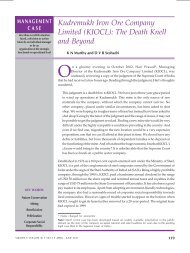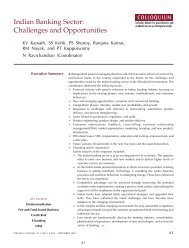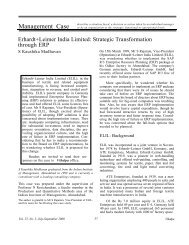Executive Summary A Study on Return on Investment of ... - Vikalpa
Executive Summary A Study on Return on Investment of ... - Vikalpa
Executive Summary A Study on Return on Investment of ... - Vikalpa
You also want an ePaper? Increase the reach of your titles
YUMPU automatically turns print PDFs into web optimized ePapers that Google loves.
cept has been expanded to all types <strong>of</strong> investments including<br />
training and educati<strong>on</strong>, change initiatives, and<br />
technology (Phillips, 2000a). With increased adopti<strong>on</strong><br />
and use, it appears that ROI is here to stay. Today, hundreds<br />
<strong>of</strong> organizati<strong>on</strong>s, representing manufacturing,<br />
service, n<strong>on</strong>-pr<strong>of</strong>it, and government, are routinely using<br />
ROI calculati<strong>on</strong>s for educati<strong>on</strong> and training programmes.<br />
A pr<strong>of</strong>essi<strong>on</strong>al society, The ROI Network,<br />
with over 500 members, allows practiti<strong>on</strong>ers an opportunity<br />
to share informati<strong>on</strong> and tools around ROI. The<br />
networks have been formed within the organizati<strong>on</strong>s to<br />
focus <strong>on</strong> the ROI and accountability issue. Almost 1,000<br />
individuals have been certified to implement the process<br />
in their organizati<strong>on</strong>s. Three casebooks have been<br />
developed to show specific applicati<strong>on</strong>s <strong>of</strong> ROI (Phillips,<br />
1994; 1997; 2000c). A fourth casebook describes successful<br />
implementati<strong>on</strong> <strong>of</strong> the ROI process (Phillips, 1998).<br />
This level <strong>of</strong> interest and activity is evidence that the<br />
ROI process is here to stay.<br />
There are good reas<strong>on</strong>s why return <strong>on</strong> investment is so<br />
significant. Although the viewpoints and explanati<strong>on</strong>s<br />
may vary, some things are very clear. First, in most organizati<strong>on</strong>s,<br />
educati<strong>on</strong> and training budgets have c<strong>on</strong>tinued<br />
to grow year after year. As expenditures grow,<br />
accountability becomes a more critical issue. A growing<br />
budget creates a larger target for internal critics, <strong>of</strong>ten<br />
prompting the development <strong>of</strong> an ROI process.<br />
Sec<strong>on</strong>d, Total Quality Management and C<strong>on</strong>tinuous Process<br />
Improvement have drawn increased attenti<strong>on</strong> to<br />
measurement issues. Today, organizati<strong>on</strong>s measure processes<br />
and outputs that were not previously measured,<br />
m<strong>on</strong>itored, and reported. This measurement focus has<br />
placed increased pressure <strong>on</strong> the educati<strong>on</strong> and training<br />
functi<strong>on</strong> to develop measures <strong>of</strong> programme success.<br />
A paper (Buckberry, 2004) has been developed to provide<br />
to members <strong>of</strong> Computer Educati<strong>on</strong> and Management<br />
Associati<strong>on</strong> (CEdMA) some basic introductory<br />
informati<strong>on</strong> and ideas to assist in the preparati<strong>on</strong> <strong>of</strong> their<br />
own customized ROI processes. CEdMA’s clients are<br />
typically purchasers <strong>of</strong> IT s<strong>of</strong>tware and hardware, and<br />
CEdMA members are resp<strong>on</strong>sible for the provisi<strong>on</strong> <strong>of</strong><br />
training to these clients. The questi<strong>on</strong> this paper addresses<br />
is, “How do we help customers understand and<br />
justify for themselves the need to invest properly and<br />
comprehensively in training, and how do we present<br />
the comparative benefits <strong>of</strong> different approaches to training?”<br />
Implementing some form <strong>of</strong> measurement proc-<br />
34<br />
ess is as important for managing training programmes<br />
and investment, as it is for any other project requiring<br />
significant financial investment by a business. Training<br />
programmes c<strong>on</strong>sume resources (i.e., they take people’s<br />
time and m<strong>on</strong>ey), but they are also critical to maximizing<br />
the return <strong>on</strong> investment in other programmes or<br />
products (e.g., the effective introducti<strong>on</strong> <strong>of</strong> s<strong>of</strong>tware systems<br />
requires users to be able to use the systems effectively<br />
if the potential benefit <strong>of</strong> the s<strong>of</strong>tware systems is<br />
to be realized in practice), as well as generally improving<br />
the productivity <strong>of</strong> the workforce. If ROI is to be<br />
successfully managed and measured, it is important that<br />
the process be included early in the planning cycle for<br />
the training programmes. (Buckberry, 2004).<br />
A study was c<strong>on</strong>ducted by Reed (1986) to determine the<br />
net impact <strong>of</strong> Job Training Partnership Act (JTPA) training.<br />
(A measure <strong>of</strong> net impact expresses <strong>on</strong>ly those gains<br />
due to training and not those due to other reas<strong>on</strong>s.) Job<br />
service applicants were chosen as a comparis<strong>on</strong> group<br />
whose recent labour market experiences would parallel<br />
those <strong>of</strong> JTPA participants. All results were positive. For<br />
men who participated in JTPA in 1983-84, the estimated<br />
effect <strong>of</strong> training was an additi<strong>on</strong>al $1,400 earned during<br />
1985. It appeared likely that the benefit persisted in<br />
1986. For white women, the estimated effect <strong>of</strong> training<br />
was an additi<strong>on</strong>al $1,000 earned in 1985. A separate estimate<br />
<strong>of</strong> the impact <strong>on</strong> earnings was made for recipients<br />
<strong>of</strong> Aid to Families with Dependent Children<br />
(AFDC). For them, the effect was an additi<strong>on</strong>al $1,200 in<br />
1985 earnings. Because their initial earnings were so low,<br />
this amounted to approximately 100 per cent <strong>of</strong> the 1979<br />
income. The reducti<strong>on</strong> in AFDC grant amounts attributable<br />
to training was another measure <strong>of</strong> impact used.<br />
Twelve m<strong>on</strong>ths after enrollment, AFDC recipients who<br />
participated in training were 86 per cent more likely not<br />
to be receiving assistance than were their counterparts<br />
who did not participate.<br />
Collins, Collins and Jensen (2009) c<strong>on</strong>cluded from their<br />
study that wisely allocating financial resources is essential<br />
to the success <strong>of</strong> every health care organizati<strong>on</strong>.<br />
Therefore, health care managers must be able to determine<br />
if dedicating the necessary funds for employee<br />
training results in an adequate return <strong>on</strong> investment.<br />
This case study examines how training programmes can<br />
be evaluated in terms <strong>of</strong> business results and describes<br />
<strong>on</strong>e method, simple regressi<strong>on</strong> analysis that health care<br />
managers may use, to help determine if the training was<br />
financially beneficial to the organizati<strong>on</strong>.<br />
A STUDY ON RETURN ON INVESTMENT OF TRAINING PROGRAMME IN A GOVERNMENT ENTERPRISE IN INDIA





